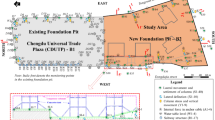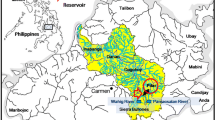Abstract
Soil compaction and substrate modification produced during large-scale armored military maneuvers in the early 1940s were examined in 1981 at seven sites in California’s eastern Mojave Desert Recording penetrometer measurements show that tracks left by a single pass of an M3 “medium” tank have average soil resistance values that are 50% greater than those of the surrounding untracked soil in the upper 20 cm At one site, measurements made along short segments of track that have been visually eliminated by erosion and deposition processes show a 73% increase in penetrometer resistance over adjacent, undisturbed soils Dirt roadways at three former base camp locations could not be penetrated below 5–10 cm because of extreme compaction Soil bulk density was not as sensitive an indicator of soil compaction as was penetrometer resistance Density values in the upper 10 cm of soil are not significantly different between tank tracks and undisturbed soils at most sites, and roadways at two base camps show an average increase in bulk density of only 12% over adjacent soils. Trench excavations across tank tracks show that physical modifications of the substrate can extend vertically beneath a track to a depth of 25 cm and outward from a track’s edge to 50 cm These soil disturbances are probably major factors that encourage accelerated soil erosion throughout the manuever area and also retard or prevent the return of vegetation to pre-disturbance conditions
Similar content being viewed by others
References Cited
Bodman, G. B., and G. K. Constantin, 1965, Influence of particle size distribution in soil compaction: Hilgardia, v. 36, p. 567–591.
Bull, W. B., 1974, Information concerning geology and seismology,in Geomorphic tectonic analysis of the Vidal Region, Vidal Nuclear Generation Station, vol. III, appendix 2.5B, Southern California Edison Co. 66 pp.
Carter, L. M., 1967, Portable recording penetrometer measures soil strength profiles: Agric. Engl. J., v. 48, p. 348–349.
Crow, D. (ed.), 1982, Armored fighting vehicles of the world. v. 1: Garden City, N.Y., Doubleday, 240 pp.
Gile, L. H., and J. W. Hawley, 1968, Age and comparative development of desert soils at the Gardner Springs radiocarbon site, New Mexico: Soil Sci. Soc. Amer. Proc., v. 32, p. 709–716.
Gile, L. H., F. F. Peterson, and R. B. Grossman, 1966, Morphological and genetic sequences of carbonate accumulation in desert soils: Soil Sci., v. 101, no. 5, p. 347–360.
Grimes, D. W., R. J. Miller, and P. L. Wiley, 1975, Cotton and corn root development in two field soils of different strength characteristics: Agron. J., v. 67, p. 519–523.
Hillel, D., 1980, Fundamental of soil physics: New York, Academic Press, 486 pp.
Iverson, R. M., B. S. Hinckley, R. M. Webb, and B. Hallet, 1981, Physical effects of vehicular disturbances on arid landscapes: Science, v. 212, no. 22, p. 915–917.
Iwasiuk, E. W., 1978, Plant response parameters to General Patton’s armored maneuvers in the eastern Mojave Desert of California: unpublished M.A. thesis, Loma Linda University, Loma Linda, CA, 85 pp.
Lathrop, E., 1982, Recovery of perennial vegetation in military maneuver areas,in Webb, R. H., and H. G. Wilshire, eds., Environmental effects of off-road vehicles: New York, Springer-Verlag Inc, p. 269–276.
Meller, S., 1946, The desert training center and C-AMA, study no 15: Washington, D.C., Historical Section, Army Ground Forces, 126 pp.
Sokal, R. R., and F. J. Rohlf, 1969, Biometry: San Francisco, CA., Freeman, 775 pp.
Taylor, H. M., and H. R. Gardner, 1963, Penetration of cotton seedling taproots as influenced by bulk density, moisture content, and strength of soil: Soil Sci., v. 96, no. 3, p. 153–156.
University of California, Irvine, 1974, Desert land-use management in California: Its ecological and sociological consequences: Irvine, CA., Natl. Sci. Found. Grant GY 11425, 268 pp.
U.S. Army Corps of Engineers, 1981, Natural resource conservation for tactical vehicle training areas: U S. Army Corp of Engineers, Technical Report N-106, 109 pp.
U.S. Bureau of Land Management, 1976, Soils inventory: East Mojave Desert, California: Riverside, CA., Desert Planning Staff, 132 pp.
U.S. Bureau of Land Management, 1980, The effects of disturbance on desert soils, vegetation, and community processes with emphasis on off-road vehicles: A critical review: Riverside, CA., Desert Planning Staff, 190 pp.
U.S. Department of the Army, 1979, Final environmental impact statement: National Training Center, Ft. Irwin Site: Fort McPherson, GA., Headquarters, U.S. Army Forces Command, 461 pp.
Voorhees, W. B., C. G. Senst, and W. W. Nelson, 1978, Compaction and soil structure modification by wheel traffic in the northern corn belt: Soil Sci. Soc. Amer. J., v. 42, p. 344–349.
Wilshire, H. G., and J. K. Nakata, 1976, Off-road vehicle effects on California’s Mojave Desert: Calif. Geol., v. 29, p. 123–132.
Wilshire, H. G., and R. H. Webb, 1980, Recovery of soils and vegetation in a Mojave Desert ghost town, Nevada U.S.A.: J. Arid Environ., v. 3, p. 291–303.
Author information
Authors and Affiliations
Rights and permissions
About this article
Cite this article
Prose, D.V. Persisting effects of armored military maneuvers on some soils of the Mojave Desert. Environ. Geol. Water Sci 7, 163–170 (1985). https://doi.org/10.1007/BF02528800
Issue Date:
DOI: https://doi.org/10.1007/BF02528800




